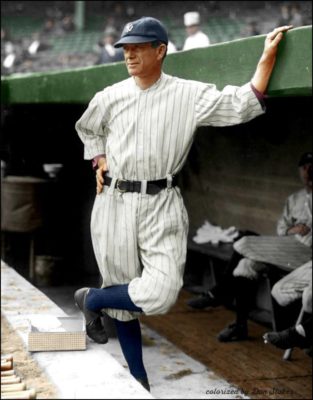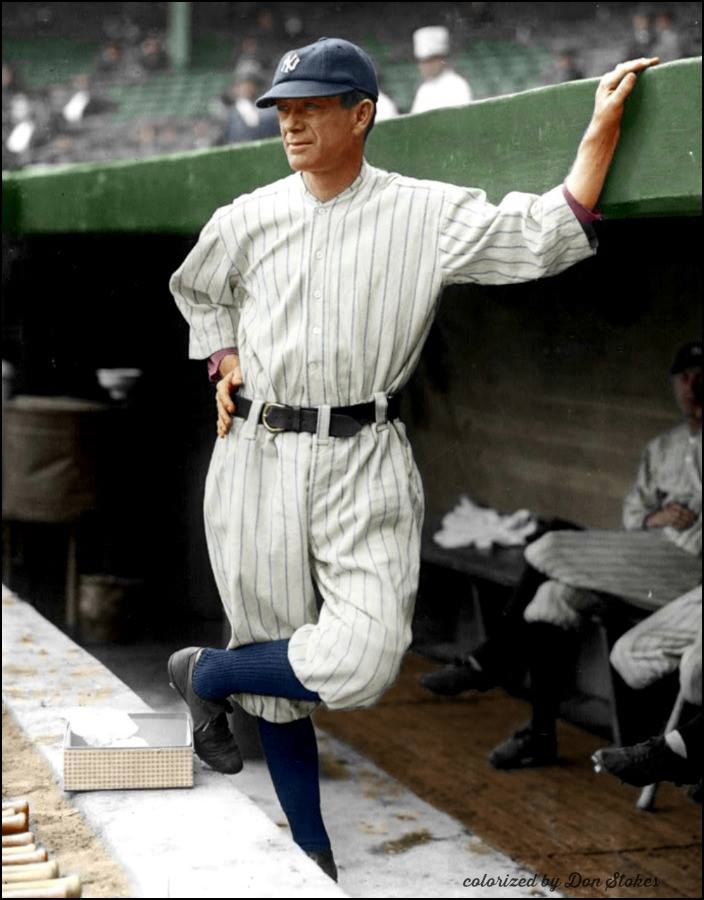Subscribe to my blog for automatic updates and Free Bonus Reports: “Memorable World Series Moments” and “Gary’s Handy Dandy World Series Reference Guide.”
Miller Huggins Photo Gallery
Click on any image below to see photos in full size and to start Photo Gallery:

The Baseball World Learns of the Death of Miller Huggins
“Hug was the only man who knew how to keep me in line.” –Babe Ruth
“Miller Huggins was one of the greatest managers I have ever met.”-Sportswriter and Hall-of-Fame umpire Billy Evans
“Sure I’m lucky… to have played six years for that wonderful little man, Miller Huggins…” –Lou Gehrig, mentioning Miller Huggins in his “Luckiest Man” Farewell Speech, July 4, 1939
It was a sad day in baseball 88 years ago today. On September 25, 1929, during the fifth inning of a game between the Red Sox and Yankees at Fenway Park, the game was stopped as all the players gathered at home plate. A telegram was read announcing the death of Yankee manager, Miller Huggins. Home plate umpire Bill McGowan requested a moment of silence and the centerfield flag was lowered to half-staff.
Miller Huggins was unquestionably one of the games’ great managers. In 17 seasons (1910-1929), his teams posted a 1413-1134 record (.555) with 23 ties. His 1413 wins ranks 23rd all-time. His first five years were less-than-stellar with the Cardinals. Probably his most notable accomplishment during this period was helping a young Rogers Hornsby with his batting stance. Things changed once he got to the Yankees in 1918. His teams went 1067-719 (.597) with six pennants and three World Series championships within an eight-year span.
In the featured photo below, we see a beautiful colorization of Miller Huggins by our resident baseball artist, Don Stokes. Click on the link to see a nice photo tribute to the great “Mighty Mite” manager, Miller Huggins:http://wp.me/p7a04E-2o3
“Hug,'” as he was affectionately called by friends and many of his his players, learned much of his managing strategy at the hands of Hall-of-Fame manger Ned Hanlon and later, Roger Bresnahan. He at first emphasized “small ball” and baseball fundamentals, characteristic of the Dead Ball Era. Of course, that all changed on a day in 1920 when a highly touted young player named Babe Ruth showed up in his Yankee clubhouse.
The cerebral Huggins earned a law degree from the University of Cincinnati but realized he could make more money playing baseball. Over his 13-year playing career (1904-’16), with the Reds and Cardinals, the compact, 5’ 5”, 140 pound speedster compiled a .265 batting average with a career .382 on-base percentage, leading the league in walks four times, and scoring 100 or more runs three times. An excellent leadoff man and defensive second baseman, he also had 324 lifetime steals, and posted a career .965 fielding average. Baseball historian Bill James ranked Huggins as the 37th best second baseman of all time.
Huggins’ repeated confrontations with Babe Ruth are well known. The Babe didn’t respect him, it’s said, due to his small stature and soft-spoken nature. Huggins, in turn, wasn’t intimidated by his star player who just happened to be about twice his size. In one memorable altercation, Huggins suspended Ruth indefinitely on August 29, 1925 for “misconduct off the playing field,” and fined him $5,000. Ruth responded he would “never play for Huggins again.” To the Babe’s surprise, Col. Ruppert sided with Huggins, confirming that Ruth would be suspended for “as long as the manager sees fit.” After apologizing to both Huggins and Ruppert, a contrite Babe Ruth was reinstated on September 5.
Huggins fell ill on September 20, 1929 with an infectious disease called erysiplas and checked into Saint Vincent’s Catholic Medical Center. He died five days later, aged 51. The American League canceled its games the following day as thousands of tearful fans paid their respects at Yankee Stadium. A moment of silence was held before the start of Game Four of the 1929 World Series. The Yankees dedicated a monument to Huggins on May 30, 1932, placing it in front of the flagpole in center field in Monument Park. Miller Huggins was elected to the Hall of Fame in 1964.
Gary Livacari
“Friend” me on Facebook: https://www.facebook.com/gary.livacari.9
Visit Our Web page: “Baseball History Comes Alive!” now with over 121K hits!:
http://wp.me/P7a04E-2he
Photo Credits: Featured photo colorized by Don Stokes: https://www.facebook.com/Don-Stokes-Old-Time-Baseball-Colorizations-923346241033508/; All others from Google search
Information: Excerpts edited from the Miller Huggins Wikipedia page.
We are a participant in the Amazon Services LLC Associates Program, an affiliate advertising program designed to provide a means for us to earn fees by linking to Amazon.com and affiliated sites. Click here to view Amazon’s privacy policy

